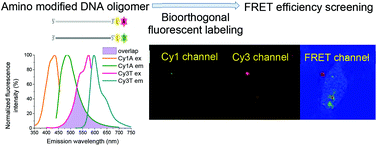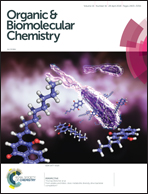A rapid and concise setup for the fast screening of FRET pairs using bioorthogonalized fluorescent dyes†
Abstract
One of the most popular means to follow interactions between bio(macro)molecules is Förster resonance energy transfer (FRET). There is large interest in widening the selection of fluorescent FRET pairs especially in the region of the red/far red range, where minimal autofluorescence is encountered. A set of bioorthogonally applicable fluorescent dyes, synthesized recently in our lab, were paired (Cy3T/Cy5T; Cy1A/Cy3T and Cy1A/CBRD1A) based on their spectral characteristics in order to test their potential in FRET applications. For fast elaboration of the selected pairs we have created a bioorthogonalized platform based on complementary 17-mer DNA oligomers. The cyclooctynylated strands were modified nearly quantitatively with the fluorophores via bioorthogonal chemistry steps, using azide- (Cy1; CBRD1) or tetrazine-modified (Cy3; Cy5) dyes. Reactions were followed by capillary electrophoresis using a method specifically developed for this project. FRET efficiencies of the fluorescent dye pairs were compared both in close proximity (5′ and 3′ matched) and at larger distance (5′ and 5′ matched). The specificity of FRET signals was further elaborated by denaturation and competition studies. Cy1A/Cy3T and Cy1A/CBRD1A introduced here as novel FRET pairs are highly recommended for FRET applications based on the significant changes in fluorescence intensities of the donor and acceptor peaks. Application of one of the FRET pairs was demonstrated in live cells, transfected with labeled oligos. Furthermore, the concise installation of the dyes allows for efficient fluorescence modification of any selected DNA strands as was demonstrated in the construction of Cy3T labeled oligomers, which were used in the FISH-based detection of Helicobacter pylori.



 Please wait while we load your content...
Please wait while we load your content...